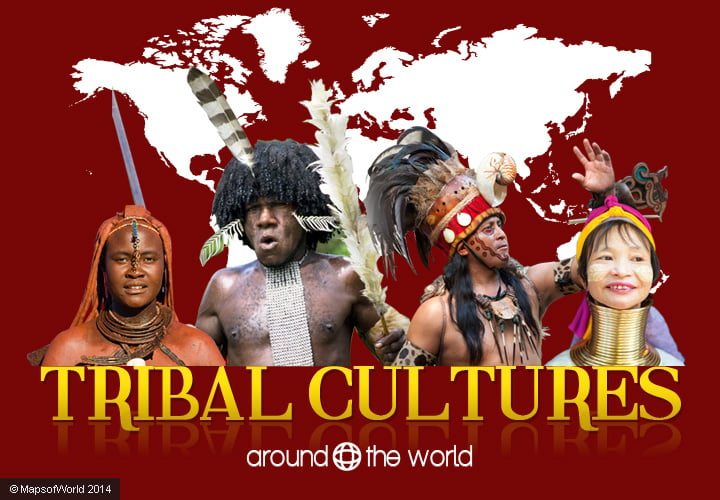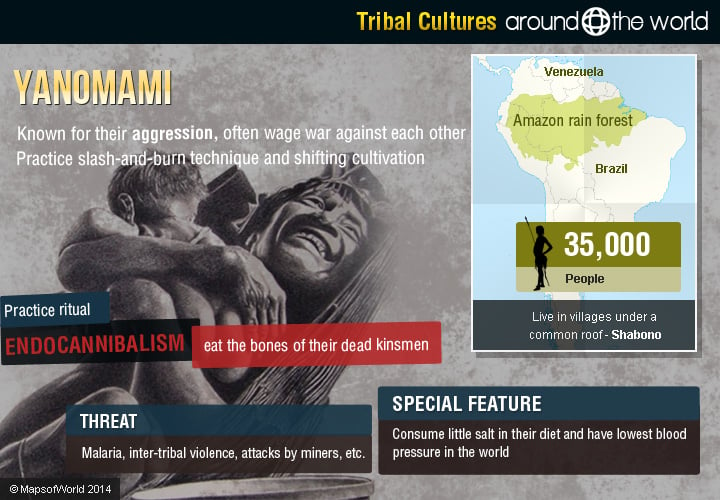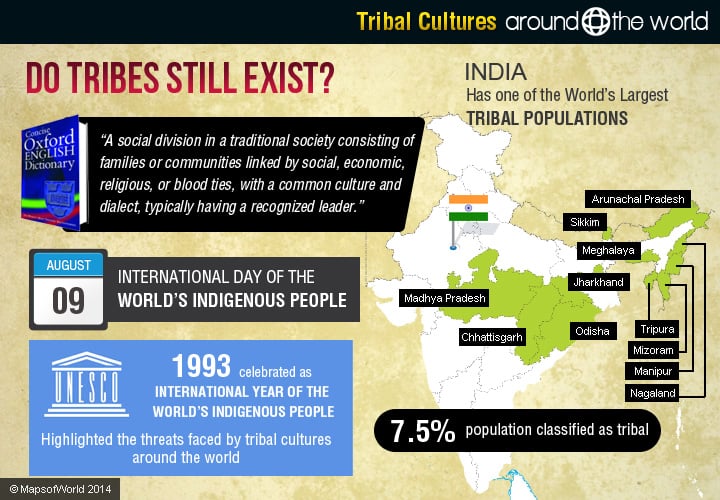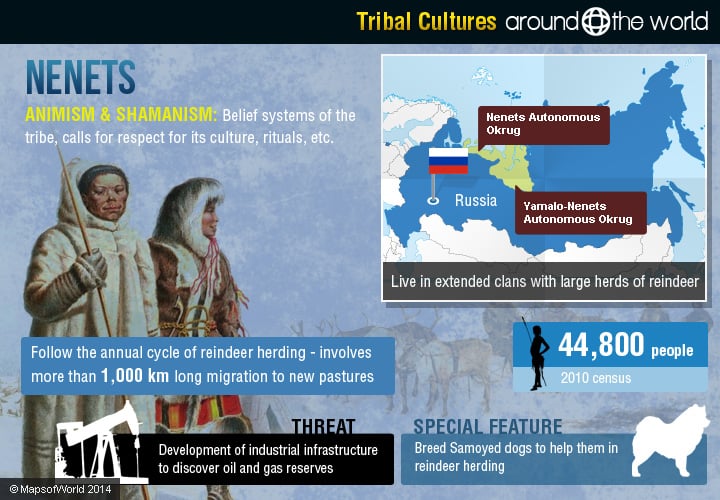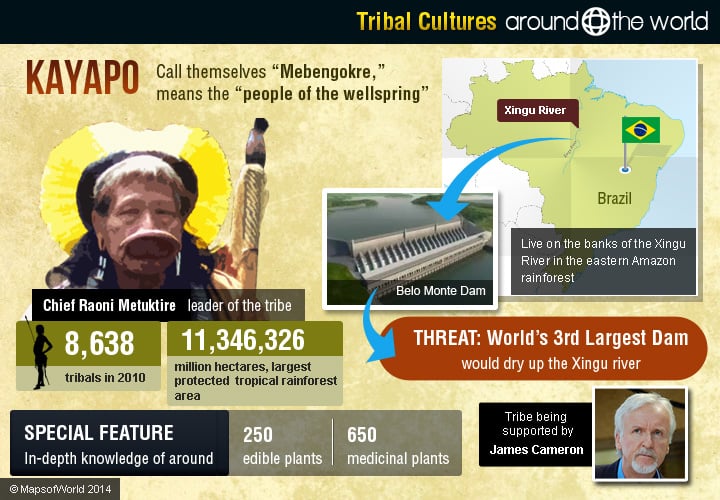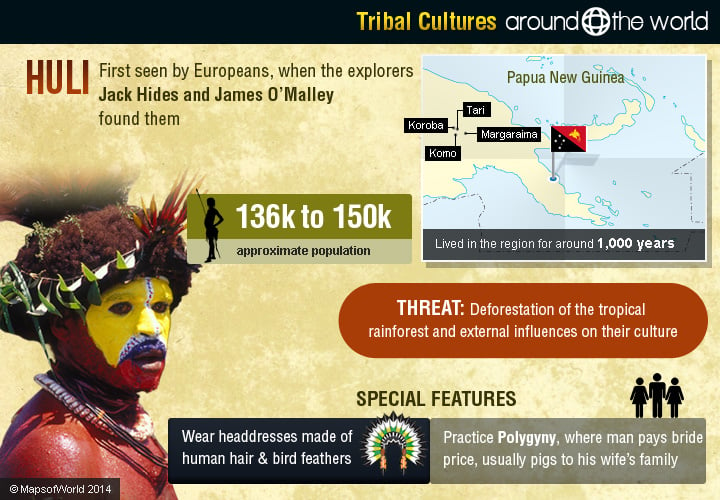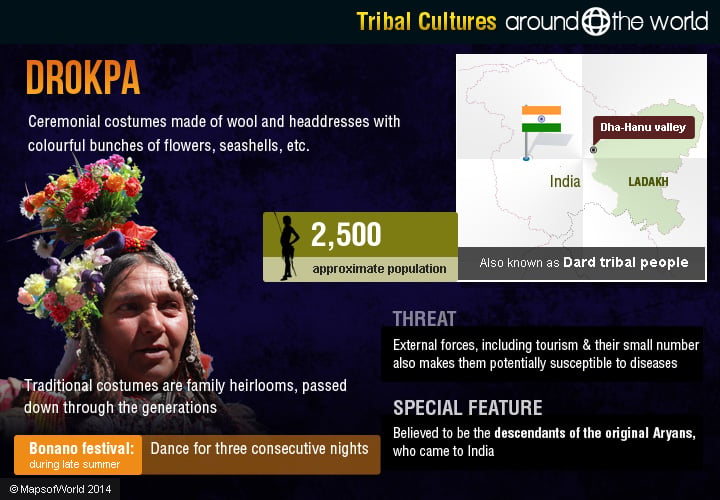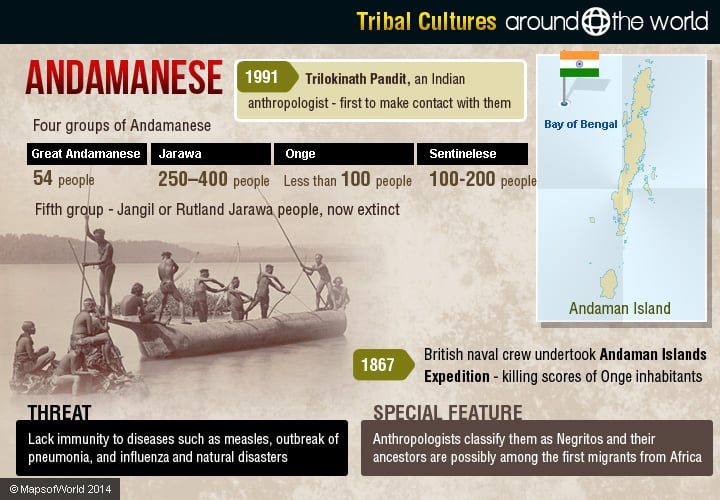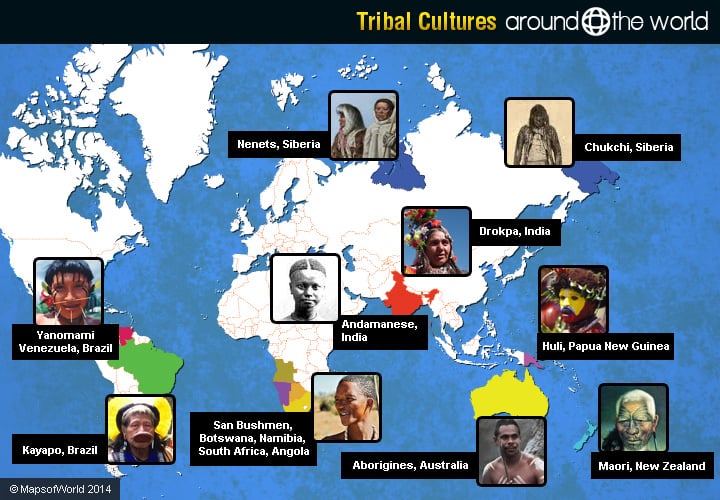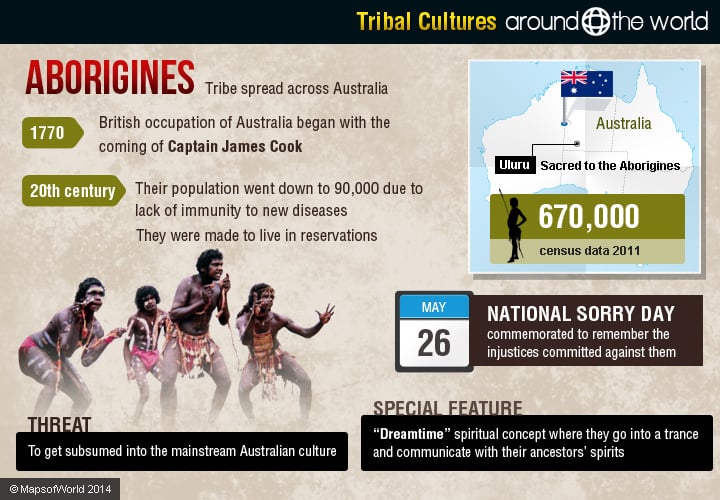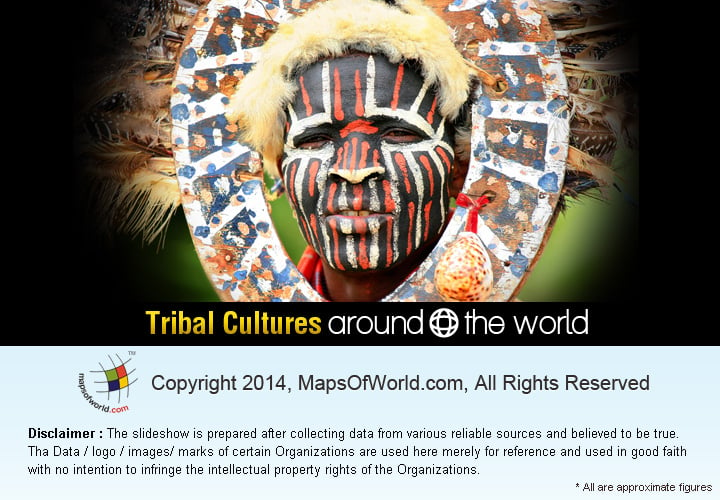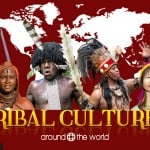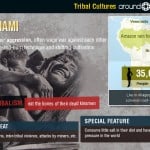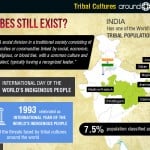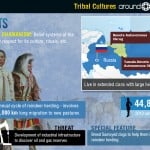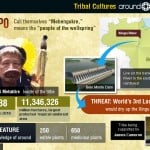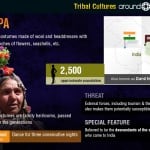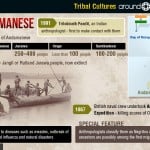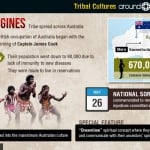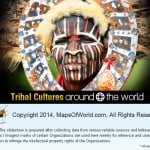Many of us may feel that our fast-paced world of increasing globalization, industrialization, and homogenization contributes to our becoming global citizens, where we are equally at home in any part of the world. However, these processes have taken a heavy toll on traditional ways of life around the world, particularly tribal cultures that are trying to preserve their age-old traditions and customs.
The Oxford Dictionary defines a tribe as “A social division in a traditional society consisting of families or communities linked by social, economic, religious, or blood ties, with a common culture and dialect, typically having a recognized leader.”
Every year August 9 is observed as the International Day of the World’s Indigenous People. The UNESCO had declared 1993 the International Year of the World’s Indigenous People in an effort to highlight the threats faced by tribal cultures around the world.
Did you know that India has one of the largest tribal populations in the world with 7.5 % of its population classified as tribal. Maximum tribal population in India is found in Madhya Pradesh, Chhattisgarh, Odisha, Jharkhand, North Eastern States (Arunachal Pradesh, Tripura, Mizoram, Manipur, Meghalaya, Nagaland), and Sikkim.
Even today there are uncontacted tribes in the Amazon rainforest, who have not met people from the outside world.
We have much to learn from tribal cultures that live close to nature, and often in harmony with nature’s rhythms. Read on to learn more about some of the world’s fascinating and endangered tribal cultures around the world.
Kayapo – Brazil (Along the banks of the Xingu River, Amazon basin)
Huli – Papua New Guinea
Chukchi – Siberia (Chukotka Autonomous region in Russia)
Drokpa – Ladakh, India
Andamanese – Andaman Islands, India
Nenets – Siberia (Yamal peninsula)
Yanomami – South America (Venezuela, Brazil)
San Bushmen – Africa (Botswana, Namibia, South Africa, Angola)
Maori – New Zealand
Aborigines – Australia
1. Tribe: Kayapo (Brazil)
Location: The Kayapo tribal people live on the banks of the Xingu River in the eastern Amazon rainforest in Brazil. They occupy an area of tropical rainforest extending across 11,346,326 million hectares, the largest protected tropical area in the world.
Population: There were approximately 8,638 Kayapo tribal in 2010.
Social Organization: The Kayapo call themselves “Mebengokre” which means the “people of the wellspring.” The Kayapo are led by Chief Raoni Metuktire. He has achieved international fame for his leadership of the fight by the indigenous inhabitants of the Amazon basin for the right to preserve the Amazon rainforest and their primitive culture. The Kayapo people live in villages that usually have about a dozen huts. They practice shifting cultivation, using the slash and burn technique. They harvest mostly sweet potato, yam, taro, and papaya.
Threatened by: The Kayapo tribal people are threatened by the construction of the Belo Monte Dam on the Xingu River. This dam is planned to be the third-largest in the world and the construction of the dam would dry up the Xingu river, which is stretched up to 60 miles. In this way, indigenous territories that are located alongside the river would be ruined.
The Kayapo have been supported in their struggle by many international celebrities, including James Cameron, who found parallels between the resistance of the tribes along the Xingu River to the dam and his movie Avatar (which depicted the struggle of the indigenous Na’avi people against exploitative mining by humans on the planet Pandora).
Special Features: They have in-depth knowledge of around 250 edible plants and 650 medicinal plants in the Amazon rainforest. This traditional knowledge is now being shared with scientists and researchers. The Kayapo people have entered into an agreement with the cosmetics company, The Body Shop, which sources natural plant extracts for its products based on the Kayapo’s knowledge.
2. Tribe: Huli – Papua New Guinea
Location: The Huli people live in the districts of Komo, Koroba, Margaraima, and Tari in the Southern Highlands of Papua New Guinea. While some of them speak English, however, their main languages are Tok Pisin and Huli.
Population: The Huli people number approximately 136,000 to 150,000 people.
Social Organization: The Huli tribal people have lived in the region for around 1,000 years. They were first seen by Europeans, when the explorers Jack Hides and James O’Malley found them. The Huli people practice shifting cultivation, which is carried out mostly by the women. They grow sweet potatoes, corn, potatoes, and cabbage. The men primarily go out hunting for small forest animals, but help clear the land for cultivation.
Threatened by: Deforestation of the tropical rainforest and external influences on their traditional culture.
Special Features: The men of the Huli tribe are known for wearing elaborate headdresses made of human hair and bird feathers. There were originally worn when going into battle against other nearby tribes. However, now they are worn more for ceremonial purposes. The Huli practice polygyny, where a man can have many wives. The man has to pay a bride price, usually a number of pigs to his wife’s family.
3. Tribe: Chukchi – Siberia
Location: The Chukchi live in the Chukotka Autonomous Okrug region in Russia. They live in the Chukchi Peninsula around the shores of the Chukchi Sea and Bering Sea in the Arctic Ocean. They speak Russian and Chukchi languages.
Population: The Chukchi number around 16,000 people.
Social Organization: The Russian word Chukchi is a derivation of the Chukchi word Chauchu which means “rich in Reindeer.” The Chukchi comprise two groups: the Reindeer Chukchi live in the inland tundra region and their livelihood is centred around herding reindeer, while the Maritime Chukchi live around the coast and hunt seals and other sea creatures.
Threatened by: The traditional lands of the Chukchi people have been polluted by oil exploration, mining, pollution, and weapons testing in the Soviet era. In the past, warfare with Russia was a major threat.
Special Features: The Chukchi people have never been conquered by the might of the Russian state. As the Chukchi are so well adapted to the harsh Arctic climate they have been able to defeat all the Russian troops sent to conquer them over the years. Now they have opened themselves to greater assimilation, including learning the Russian language.
The Chukchi people believe that all objects have a spirit which can be either beneficial or harmful. Sharing and hospitality are highly valued among the Chukchi people.
4. Tribe: Drokpa – Ladakh, India
Location: The Drokpa tribal people live in the Dha-Hanu valley of Ladakh, in Jammu & Kashmir state in India. They are also called the Dard tribal people.
Population: The Drokpas number around 2,500 people.
Social Organization: The Drokpas live in close-knit communities and practice animal husbandry and agriculture. They wear colourful ceremonial costumes made of wool and headdresses with colourful bunches of flowers on their heads, seashells, and coins. These traditional costumes are family heirlooms and are passed down through the generations.
They are culturally vibrant, which is reflected in their interests for dance, music, elaborate outfits and ornaments. They celebrate Bonano festival during the late summer , when the Dropkas dance for three consecutive nights.
Threatened by: Though the Drokpas resist external influences, their ways of life is threatened by external forces, including tourism. Their small number also makes them potentially susceptible to diseases to which they do not have immunity.
Special Features: The Drokpas are believed to be the descendants of the original Aryans, who came to India. A story attributes their origin to the soldiers of Alexander, who stayed behind in the Indian subcontinent after being defeated by King Porus in 326 BC. An alternative theory attributes their origin to the Dards, an Aryan tribe that migrated to the Dha-Hanu valley and were cut off from the rest of their tribal people over the centuries.
5. Tribe: Andamanese – Andaman Islands, India
Location: The four groups of Andamanese tribal people live in the Andaman Islands, in the Bay of Bengal in the Indian Ocean.
Population: The four groups of Andamanese are: Great Andamanese (about 54 people), Jarawa (250–400 people), Onge (less than 100 people), Sentinelese (100–200 people). A fifth group, the Jangil or Rutland Jarawa people are now extinct.
Social Organization: While the Andamanese and the Onge accepted contact with the local Indian administration, the Sentinelese and the Jarawa resisted attempts to make contact. The 54 Andamanese live on a reservation in Strait Island while the Onge live on two reservations on Little Andaman Island. The Jarawa initially occupied Jarawa Island, but later migrated to the western coast of the Andaman Island. The Sentinelese live on North Sentinel Island and in 1991 an Indian anthropologist Trilokinath Pandit was the first to make contact with them. The Andamanese were hunter gatherers and did not practice cultivation till they came in contact with outsiders. They did not know how to make fire till the 19th century and would carry embers from lightning – struck trees in carefully hollowed out wooden logs to start a new fire.
Threatened by: Their small population, lack immunity to diseases such as measles, outbreak of pneumonia, and influenza and natural disasters that took heavy toll on them.
In the past, they were killed by the British and Japanese occupation forces. In the year 1867, British naval crew undertook Andaman Islands Expedition, in which scores of Onge inhabitants lost their lives. In 1940s, on the other hand, Japan shelled bombs on the Jarawa that further contributed to the extinction of the tribes.
Special Features: Anthropologists classify the Andamanese as Negritos and their ancestors are possibly among the first migrants from Africa who traveled along the Indian mainland coastal regions towards Japan, Southeast Asia, and Oceania.
6. Tribe: Nenets – Siberia, Russia
Location: The Nenets people live in the Yamal Peninsula in Siberia, Russia, in the Nenets Autonomous Okrug and Yamalo-Nenets Autonomous Okrug.
Population: The Nenets number around 44,800 people, according to the 2010 census.
Social Organization: The Nenets live in extended clans or family groups with large herds of reindeer. Their life revolves around the annual cycle of reindeer herding, including a more than 1,000 km long migration to new pastures that involves crossing the frozen Ob River. The Nenets believe in animism and shamanism. These are the belief systems of the tribe that calls for respect for its culture, rituals, resources, and land.
During the Stalin era in Russia, all Nenets children compulsorily had to attend Soviet boarding schools and learn the Russian language as a way of being assimilated into the larger Soviet state. Now education has become an essential part of the Nenets, thus giving them the opportunities to come to the fore – Anna Nerkagi is one of the prominent writers among the Nenets, Konstantin Pankov and Tyko Vylka became famous painters.
Threatened by: The discovery of oil and gas reserves on the Yamal Peninsula in the 1970s and the development of industrial infrastructure to extract these resources has impacted the Nenets way of life. Pastures for reindeers have shrunk and climate change is now another major threat for them.
Special Features: The Nenets people breed Samoyed dogs to help them in reindeer herding. These dogs have thick fur and are well-adapted to Arctic weather and have become popular sled dogs for Arctic expeditions by European explorers.
7. Tribe: Yanomami – South America
Location: The Yanomami people live in the Amazon rain forest along the border between Venezuela and Brazil.
Population: The Yanomami number around 35,000 people.
Social Organization: The Yanomami live in villages under a common roof called a Shabono. The men are mainly fishers, hunters, and gatherers while women cultivate crops such as cassava, plantains, cotton, and tobacco. They practice slash-and-burn technique and shifting cultivation when the land becomes overused. The Yanomami men are known for their aggression and tribes often wage war against each other. Yanomami men have been known to kill the children of other tribes during raids. They also practice ritual endocannibalism, wherein they eat the bones of their kinsmen, who have passed away.
Threatened by: Malaria, malnourishment, inter-tribal violence, and attacks by miners and loggers encroaching on their traditional lands.
Special Features: The Yanomami people consume very little salt in their diet and have among the lowest blood pressure of any people around the world. This has led to their becoming the subject of scientific research on hypertension’s correlation with salt consumption.
8. Tribe: San People or Bushmen – Africa
Location: The San People or Bushmen (also called Basarwa) live in Botswana, Namibia, South Africa, and Angola.
Population: There are around 90,000 San Bushmen spread over these four African countries with 55,000 in Botswana, 27,000 in Namibia, 10,000 in South Africa, and less than 5,000 in Angola.
Social Organization: The San people live in family groups and traditionally have practiced a hunter-gatherer way of life. However, since the 1950s, they have taken to more settled agriculture with the help of the government. Women have an equal place of respect in San society. The San people have in-depth knowledge of the plants and animals of their region.
Threatened by:. 13 December 2006, proved a historic win for the San people as the government’s attempt to evict the tribe from their ancestral land was deemed as illegal by the court. The tribe was restored to its ancestral reserve. However, problem of lack of access to their traditional hunting grounds still persists.
Many people of the tribe are gripped by the diseases such as TB, HIV/AIDS, depression, etc.
Special Features: Scientists have carried out genetic studies of San people and concluded that San are one the of 14 living “ancestral population clusters” from which all modern human beings have descended. An extract of the plant, Hoodia gordonii, has been patented by the South African Council for Scientific and Industrial Research (CSIR) for its property of suppressing the appetite. An agreement to share any profits from the development of drugs based on this plant has been signed by the San people and CSIR.
Moreover, their Central Kalahari Game Reserve in Botswana is situated in the middle of the diamond-producing region on earth. In May 2007, De Beers (cartel of companies involved in diamond trade) sold to Gem Diamonds its deposit at Gope, a Bushman community for $34 million.
The comedy movie The Gods Must Be Crazy in 1980 depicts San tribe’s first encounter with an artifact (a Coca-Cola bottle) from the outside world.
9. Tribe: Maori – New Zealand
Location: The Maori people are found mainly in New Zealand with some living in Australia, Uk, US, Canada, and other regions.
Population: There are about 750,000 Maori people. About 598,605 Maori people live in New Zealand, 126,000 live in Australia, approximately 8,000 in UK, nearly 3,500 in the US, about 1,305 in Canada, and approximately 8,000 in other regions.
Social Organization: The Maori people originated in Polynesia and came to New Zealand between 1250 and 1300 BCE. The Maoris live in clan groups and have a warrior culture, characterized by elaborate tattoos on their faces and bodies. This art of elaborate tattooing in the Maori clan tells an interesting story. Moko (male facial tattoo) – the tattoo is not considered less than a passport or an identity card as the status, position, and virility of the men are reflected in Moko, which is combined with certain outward symbols. For instance, the chief of the clan is recognized through a dog cloak that he wears and Moko.
It is fascinating to note that for the Maori on each side of the face ancestry is denoted. The right side is usually the mother’s side whereas the left side indicates the ancestry of the father. So in order to undertake Moko, descent is a prerequiste.
With the coming of Europeans they came into conflict with the newcomers and many Maori succumbed to diseases. The Maori culture has seen a revival in the 20th century with Maori’s gaining greater space in the public life of New Zealand.
Threatened by: Drug abuse, alcohol, economic, social, and educational deprivation.
Special Features: The Maori war dance, the Kapa Haka, has become famous worldwide after being adopted by the New Zealand Rugby team, the New Zealand All Blacks. The dance, which involves chanting and posturing is meant to intimidate the opponents before battle and has become an iconic part of the All Blacks’ pre-game routine.
10. Tribe: Aborigines – Australia
Location: Australia
Population: The Aboriginal people number around 670,000, according to the census data of 2011.
Social Organization: The Aborigines traditionally lived in tribal groups spread across Australia. However, with the coming of Captain James Cook in 1770, the British occupation of Australia began. The Aborigines suffered a drastic population decline due to lack of immunity to new diseases. In the 20th century when their population went down to about 90,000 they were made to live in reservations and a large number of Aboriginal children were taken away from their parents to be brought up by the state in boarding schools. These children constitute the “Stolen Generations.” In February 2008, the Australian government headed by Kevin Rudd has apologized for the crimes against the Aborigines and the Stolen Generation.
Threatened by: While the Aborigines are now present in significant numbers their traditional way of life faces the danger of being subsumed into the mainstream Australian culture.
Special Features: The Aborigines have a spiritual concept of “Dreamtime” where they go into a trance and communicate with their ancestors and guardian spirits. Some sites in Australia, such as Uluru (also called Ayers Rock) are sacred to the Aborigine people.
A “National Sorry Day” is commemorated each year on May 26 to remember the injustices committed against the Aborigine people.
Read More
- Most Expensive Cheese around the World
- Wines and Vineyards Around the World
- Drinks To Try Around the World
- Dance Forms Around the World
- Christmas Myths and Legends
- How to Say Hello around the World?
- The Dying Art of Hand Writing
- China to do away with one-child policy
- All you need to know about Halloween
- Top 10 Favorite Wines
- Ten Most Relished Foods Around the World
- Tribes Around the World
- Food Festivals Around the World
- Gay Laws Around the World
- Matriarchy Around the World
- Royal Families Around the World


